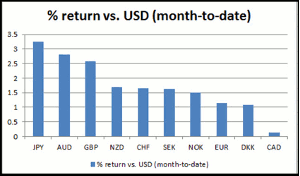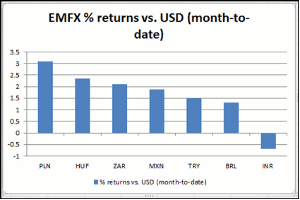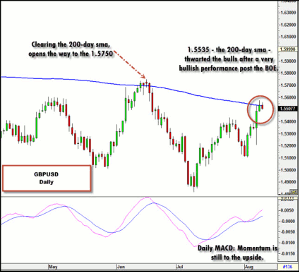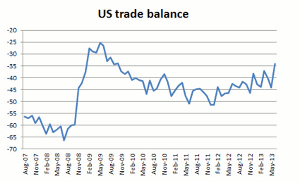Kathleen Brooks and Eric Viloria, CMT, of Forex.com highlight the events and indicators likely to shape the forex markets this week.
FX Return Analysis
It was another torrid week for the dollar; the greenback was the most sold currency in the G10. It’s been a fairly rough few weeks for the buck, and right now there is no sign that the sell-off is about to come to an end, at least not in the short term. The fact that the dollar was weak even with some hawkish commentary from some Fed members and growing speculation that the Federal Reserve will taper asset purchases as early as next month, suggests to us that there is little interest to buy the dollar yet, and there may be further downside in the short term.

Figure 1
Source: FOREX.com and Bloomberg (Prices displayed on the chart might not reflect Forex.com prices)
Click
to Enlarge
Interestingly, the dollar sell-off was most pronounced against the yen and the AUD, some of the weakest performers in the G10 so far this year. This suggests that some of the dollar weakness may have been down to positioning. Although the dollar still looks vulnerable, essentially the medium-term uptrend in USD/JPY and downtrend in AUD/USD remains in place for now.
The pound also received a boost after the market challenged the Bank of England’s pledge to keep interest rates low until Q3 2016. Elsewhere, the NZD and CHF managed to ride on the coat tails of the AUD and JPY. The EUR also trended higher last week; however gains were more muted than elsewhere as the focus was not on the Eurozone last week.
This week, we think the dollar’s fortunes will be dependent on economic data, in particular Thursday’s US CPI data. If this is stronger than expected, then the market may re-focus its attention on the prospect of Fed tapering later this year.

Figure 2
Source: FOREX.com and Bloomberg (Prices displayed on the chart might not reflect Forex.com prices)
Click
to Enlarge
As you can see above, the sell-off in the USD has not been limited to G10 currencies, some emerging market currencies have also managed to claw back gains, suggesting that this is a broad-based dollar sell-off. The rand and the HUF had suffered earlier this summer on the back of Fed tapering fears, however, it appears the cap on Treasury yields, they haven’t risen above 2.65% in the last five days, has helped beleaguered EM currencies.
The Indian rupee is the weakest performer in the emerging sphere and plunged to another record low versus the dollar last week. Sentiment remains negative on the rupee as weak economic growth and twin fiscal and trade deficits raise concerns about the economic prospects for India. While Hungary and South Africa also share deep-seated economic problems, the market is not focusing on them right now. However, do watch where the EM FX world goes next. If Treasury yields rise then these currencies are vulnerable to a sell off versus the greenback, which could be a lead indicator of a broad dollar recovery.
NEXT PAGE: Is Pound Strength Here to Stay?
|pagebreak|Is Pound Strength Here to Stay?
If the aim of the Bank of England’s forward guidance was to push market interest rates lower, it failed spectacularly. After the BOE announced it was introducing forward guidance and linking the future path of interest rates to unemployment, two-year interest rates actually rose, and although they have fallen back since, yields remain more than 10 basis points higher than there they were in May, pre to the Fed’s taper speculation. Rising rates also boosted the pound; it closed last week up 250 pips.
So why the adverse market reaction to forward guidance? Although the Bank pledged to keep interest rates low for as long as the unemployment rate remained above 7% (it’s currently at 7.8%), it included a number of caveats that may render the forward guidance null and void. The most striking caveat, or knockout, was regarding inflation. The Bank’s chief mandate still remains inflation; the unemployment rate is only a threshold. If inflation is above the 0.5% target rate for more than six months, then the bank could raise rates even if the unemployment rate is above 7%. Thus, the market may be anticipating strong inflation for the long term, which could force the Bank to raise rates. Since the BOE under Mervyn King lived with above-target inflation for most of the last five years, forward guidance was perceived as having a hawkish tone.
Although we believe that we are still some ways from a rate hike in the UK, we think that the BOE’s expectation that it will be three years before a rate hike is excessive. The economy looks like it has turned a corner, particularly the services sector, and a 7% unemployment target is not that ambitious (for example, in the US the Federal Reserve has a 6.5% unemployment rate threshold). Thus, the economy could reach a sufficient strength to justify a rate increase before Q3 2016.
The market bought the pound to challenge the BOE’s assumptions included in its forward guidance. This does not mean that the market thinks the BOE has got its forecasts wrong, rather that the BOE has left itself plenty of escape clauses to change its guidance as and when conditions shift. It makes sense that Carney should not have backed himself into a corner in his first Inflation Report, but the by-product of this is a stronger GBP.
GBP/USD hit some resistance around 1.5535—the 200-day moving average—on Friday; above here is a very bullish development that opens the way to the 1.5750, the highs from mid-June. If we reach these dizzy heights will depend on two things: 1, the UK economy maintaining its recent upside momentum, 2, relatively downbeat US economic data, and 3, the most important reason, in our view: the prospects of Fed tapering shifting from September to late 2013/ early 2014, which could cap dollar gains. In the short term, while we expect a pullback after such a surge higher, we think that GBP/USD losses may be capped to 1.5250—the lows pre the BOE report.

Figure 3
Source: FOREX.com
Click
to Enlarge
Fundamental Wrap: UK and Europe
As we mentioned above, the future direction of the pound may be dependent on economic developments. The most important fundamental releases out of the UK next week are likely to be CPI on Tuesday and the minutes of the August monetary policy meeting on Wednesday. We believe that the MPC voted unanimously to introduce forward guidance; however we may get some insight into how comfortable some members are with the prospect of pledging to keep rates low for a set period. We know that members Bean and Dale had expressed reservations about forward guidance in the past so that may be why the forward guidance was considered fairly tame and why the three “knockout” clauses were included.
The most market-moving data could be July inflation. Prices are expected to remain flat in July, and the annual rate is expected to moderate to 2.8% from 2.9% in June. The market will be looking to see if 2.9% was the peak in prices, if not then the BOE may be forced to revise its forward guidance as the longer inflation remains above the 2% target, the larger the chance that the BOE may have to raise interest rates. Thus, there is a risk that GBP/USD extends its gains if inflation remains elevated.
In Europe the focus will be on the GDP reports released on Wednesday. The market expects the Eurozone to emerge from seven quarters of recession and is expecting a 0.2% quarterly gain. The data from the periphery was positive and suggests that these economies could have turned a corner. Even if the Eurozone does register positive growth in Q2, it is still expected to contract on an annualized basis, so the reality is that the Eurozone is still slowing, just at a slower pace. Expectations are for Germany to register fairly strong growth at 0.6%, while the Netherlands and France are also expected to register positive growth. We continue to expect the Eurozone economy to remain uneven, with Germany doing most of the heavy lifting. This is likely to be reflected in a fairly strong German ZEW survey, which is expected to remain at a high level for August.
On a broad-basis the EUR was lower on the week although it was higher against the USD. The single currency was not the main event last week; hence interest in pushing positioning one way or the other was not particularly high. The break above 1.3315 in EUR/USD, the 61.8% retracement of the February high to June low, was a bullish development. However, it ran into some resistance at 1.3405—the 200-day SMA. If EUR/USD is to get above this hurdle then we may need to see some positive data surprises in the Eurozone or further USD weakness.
Fed Officials Discuss Taper Prospects
Federal Reserve officials from both sides of the hawkish/dovish spectrum have been indicating increasing willingness to reduce the pace of asset purchases (QE) if the economy continues to improve. This past week’s speakers included the Dallas Fed President Fisher (hawk, non-voter), Chicago’s Evans (dove, voter), and Cleveland Fed President Pianalto (dove, non-voter).
Evans, who is arguably the most dovish member of the FOMC, said that he would “clearly” not rule out a September tapering and reiterated that a reduction in purchases is “data-dependent”. He also noted that the recent jump in yields is not as harmful to growth as initially thought. One of the more hawkish members, Fisher, said that the FOMC is now “closer to execution mode” on tapering and said that the bank may start to cut bond purchases next month. Cleveland’s Pianalto indicated that she sees “meaningful improvement” in the labor market and is prepared to reduce bond purchases if the improvement continues.
Overall, the various Fed officials indicated the potential for imminent tapering if data shows notable improvement. This places emphasis on the August employment report which will be released in the beginning of September as it may determine whether or not the Fed is ready to pull the trigger on scaling back QE. With the uncertainty regarding the timing of tapering, FX markets have been reluctant to buy dollars and the buck has softened.
In the week ahead, Atlanta Fed President Lockhart is schedule to speak on the economy on Tuesday. Later in the week, St. Louis Fed President and FOMC voter, James Bullard, will speak on the economy and monetary policy. We think that they will echo recent commentary regarding the improving economic outlook and highlight cautious optimism while reiterating that tapering remains data-dependent.
NEXT PAGE: Will the AUD Rebound Last? |pagebreak|
Fundamental Wrap: US
Economic data released this past week was mixed. Some bright spots were the ISM non-manufacturing index which jumped to 56.0 from the prior 52.8 (cons. 53.1) and June trade balance figures that showed the lowest deficit since October 2009 with a reading of -$34.2B (vs. exp -$43.5B and prior -$44.1B). This suggests potential upward revisions for US second quarter GDP. On the other hand, wholesale inventories fell for a third straight month with a surprising decline of -0.2% (cons. +0.4%) and weekly initial jobless claims ticked higher to 333K from an upwardly revised 328K in the prior week. Amid the mixed, the USD traded on the back foot this week and US equities were softer.

Figure 4: The narrowest trade deficit since 2009 indicates a possible upward revision to GDP figures
Source: FOREX.com and Bloomberg (Prices displayed on the chart might not reflect Forex.com prices
Click
to Enlarge
There will be a slew of significant economic indicators released this week which include July retail sales, consumer and producer prices, regional manufacturing surveys (Empire manufacturing & Philadelphia Fed), industrial production, housing starts, building permits, and the University of Michigan sentiment results. Of note will be inflation data as it is a primary concern of the Federal Reserve and housing data will be closely monitored as well to determine if improvement can be sustained in the face of higher rates.
Will the AUD Rebound Last?
On Tuesday, the Reserve Bank of Australia (RBA) cut interest rates by 25bps to 2.50%. This was largely priced in and the AUD rebounded following the Bank’s decision as it took more of a neutral stance. Chinese economic data also benefitted the Australian currency as Chinese trade data showed a surge in imports of 10.9% in July from the previous year (the market was forecasting a 1.0% y/y increase). The Australian and Chinese economies are strongly tied as Australia exports natural resources to China. So, when Chinese imports are up this suggests the potential for increased demand of Australian exports. Another positive data point out of China included a 9.7% y/y increase in July industrial production which was higher than the consensus forecast of 8.9%.
AUD/USD has rebounded after reaching oversold levels and the pair is currently testing around the 0.9200 figure. The key long term pivot is around the 0.9400 figure which contains the highs of 2009 and 2010, while providing support for the lows of 2011. In our view, while AUD/USD remains below the 0.94 level there is scope for continued downside. The RBA statement even indicated that the AUD “remains at a high level” and “it is possible that the exchange rate will depreciate further” despite a nearly 15% drop since early April. The Australian economy still faces a period of rebalancing and while the prospect for further cuts may be diminished, there still exists the potential for additional rate cuts if the outlook deteriorates.
By Kathleen Brooks and Eric Viloria, CMT, of Forex.com




















